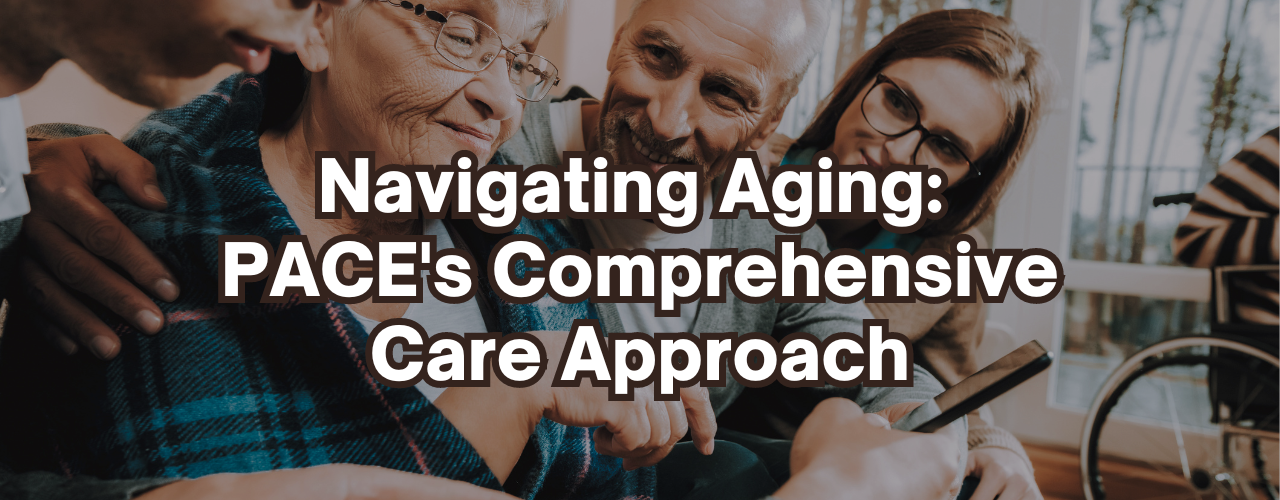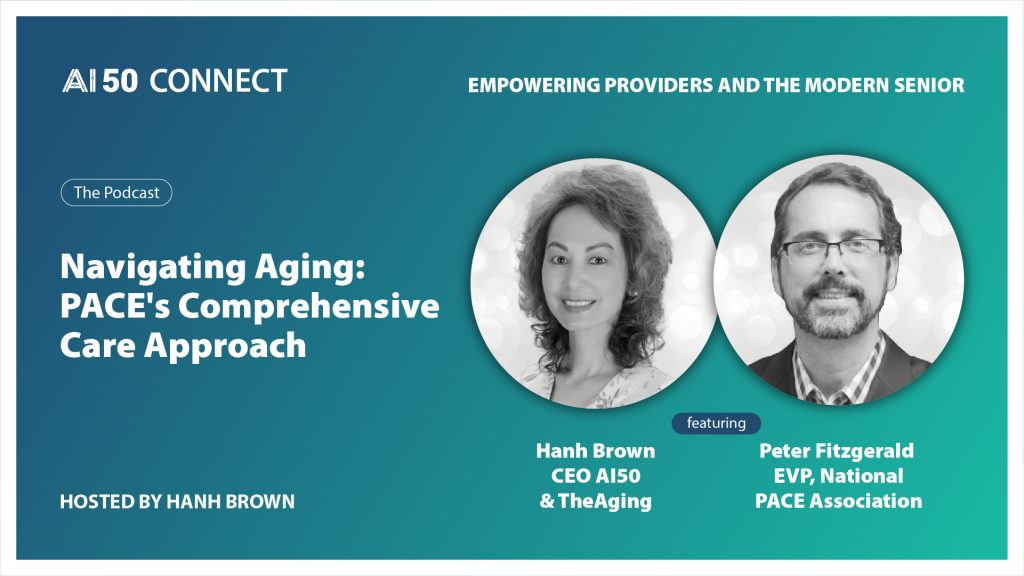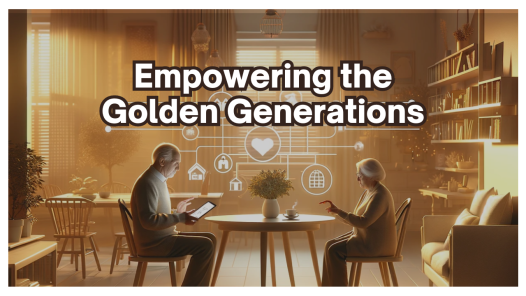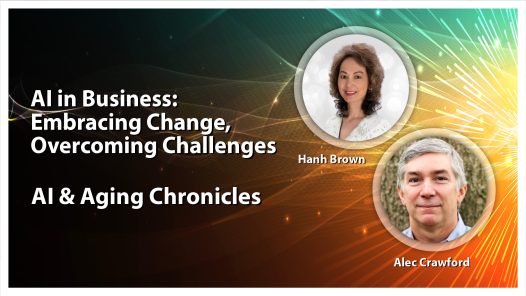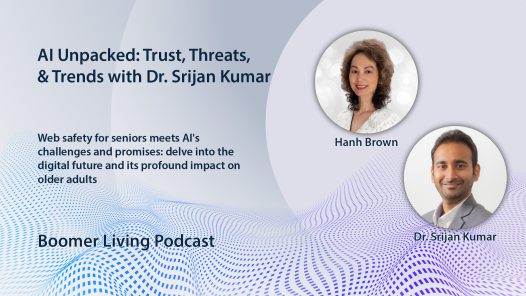Join us for a compelling episode of the AI50 Connect with Peter Fitzgerald, an authority on the Program of All-Inclusive Care for the Elderly (PACE).
In this concise yet comprehensive conversation, we explore the essence of PACE, its evolution as an alternative to traditional nursing homes, and the breadth of its care services, including medical, rehabilitation, and medication management.
Peter elaborates on PACE’s approach to challenges such as transportation, home living support, and financial aspects like eliminating co-pays and coverage gaps.
Key to this episode is the discussion on the integration of AI into PACE, examining its current use in predictive analysis and remote monitoring, and the potential future advancements in senior care. This episode is a deep dive into how PACE is shaping the future of healthcare for the elderly.
Follow Peter on LinkedIn: https://www.linkedin.com/in/peter-fitzgerald-850bbb/
👉 See our Website: https://podcast.boomerliving.tv/
🎙 Boomer Living Podcast: https://hanhdbrown.com/
👉 LinkedIn: https://bit.ly/2TFIbbd
Transcript:
Hanh:
Hello, I’m Hanh Brown, and welcome to our LinkedIn Live event. What was once known as Boomer Living Broadcast has evolved into something more fitting. AI’s 50 Connect, a platform dedicated to empowering providers and consumers alike. Well, why the change? Well, at AI50 Connect, we’re pioneering the senior care, integrating empathetic
Hanh:
AI, not just for healthcare, but for a holistic approach encompassing wellness, wealth, purposeful living, financial planning, cultural enrichment, and lifestyle enhancement. Our partnership with Microsoft Azure and OpenAI’s Enterprise It’s really the key of this journey, helping us craft an AI ecosystem that’s not only intelligent, but also deeply attuned
Hanh:
to the needs of the aging population. So our mission is clear, to address the gaps in the senior care with solutions that are both efficient and reliable. At AI50, privacy and security are paramount. We handle all data with utmost respect and care. So we’re focused on enhancing the quality of life for seniors.
Hanh:
Our tools are designed to be user friendly, empowering caregivers to work more effectively and compassionately. For us, the blend of empathy and technology is crucial. We’re committed to shaping a future where technology in senior care isn’t just about support. It’s about enrichment. We’re here to make a positive
Hanh:
change in the lives of our seniors and those who care for them. One innovation at a time. So, today’s topic is Navigating Aging, PACE’s Comprehensive Care Approach. We will do a deep dive into the transformative world of senior health care. I’m joined by Peter Fitzgerald, Executive Vice President of Policy and Strategy
Hanh:
at the National PACE Association. So Peter brings a wealth of experience in the advocating for integrated health care for high need populations. Blending his expertise in non profit organizations, Medicaid and Medicare. So, in this episode, we’ll explore the evolution of PACE, its innovative approaches to senior care. Challenges face and the exciting
Hanh:
potential of AI integration in enhancing senior care services. So join us, whether you’re watching, listening, as we unravel the intricacies of PACE and its significant impact on the aging community. So, Peter, welcome to the show.
Peter:
Hi, good morning, Hanh. Nice to be here.
Hanh:
Great. Well, thank you. Thank you for your time and shedding light on this important work that you’re doing. Can you share with us something about yourself, maybe personally or professionally that you want the audience to know?
Peter:
Uh, well, I’ve been working in the program of all inclusive care for the elderly, uh, pace for most of my professional life. I, I came to it after. Working in both nursing homes and managed care. And as we, we may get into a little bit today, uh, when I saw pace, it sort of brought together both of
Peter:
those worlds, but also, uh, a very innovative approach to meeting the care needs of older adults in a much more. Integrated way, I think in a much more human and humane way so that I was, I was very much drawn to that. Um, I’ve reflected, you know, one of the things that gives me a lot of personal satisfaction working on pace is, uh, I was very close to both of my grandmothers.
Peter:
Um, both of my grandfathers had passed Uh, when I was pretty, pretty young, but I knew both of my grandmothers quite well, uh, lived with one for one summer, um, spent a lot of time with another and just had such admiration for them. They were both very independent, strong people. And, um, I think what’s fulfilling for me about peace is giving more seniors, more
Peter:
older adults, the opportunity to live high quality lives, uh, of independence. and autonomy, um, where they’re able to live out most of their lives at home, which is where we know most older adults want to be.
Hanh:
Mm hmm. Thank you so much. So this program is revolutionizing the way we approach care for our aging population. So let’s start by understanding the fundamentals. So can you provide an overview of what PACE is and its main objectives?
Peter:
Yes. So the name is actually pretty descriptive. As I said, it’s the Program of All Inclusive Care for the Elderly. It started out in, uh, Chinatown in San Francisco, where that population was looking at where to put older, how to take care of their older adults as they aged. And at that time, The only option
Peter:
was a nursing home that was a good distance outside of the city, difficult to get to, and really represented a severing of those family ties. As people aged, which was very much not consistent with their cultural values and family values. So the first thing they thought to do, because this was over 50 years ago, uh, first thing they thought
Peter:
to do was, well, let’s build a nursing home closer in to the city. So at least we can get out there and see these folks, um, which is, which is ironic because now the pace model is all about keeping people out of their home as long as possible. But back then that was all they thought they could do. And.
Peter:
And even then, uh, real estate in San Francisco was expensive, maybe a little more affordable today, uh, given some of the economic challenges, but, um, they couldn’t find a place to build a nursing home. So they got creative and they found a place where people could come for the day. Um, and with the support of the daycare and activities programs,
Peter:
uh, continue to live at home. And over time, that care model, which was called An Loc, which in Cantonese means peaceful, happy abode, they kept seeing the additional things that people needed. So people needed primary care, people needed transportation, people needed food, um, people needed somebody to help them if they did have to go to the hospital, plan for that transition back home.
Peter:
So over time, the care model just kept adding. Different services so that they could be comprehensive and, and fully integrated. Um, and that’s the genesis of PACE. It was successful for the community in San Francisco. It was replicated through a series, two different national, uh, demonstration programs.
Peter:
Um, and now there are about 155 PACE organizations operating across the country. In 32 states, um, and the District of Columbia, just a little bit more on the model because you’re, you’re our listeners and viewers might be interested in this piece is a Medicare and a Medicaid program. So for most of the people in the program.
Peter:
Uh, they’re, the costs of care to be in PACE are being paid fully by those two programs. Uh, PACE is a little different in that it has no co pays and no deductibles. So for those of us who are used to having to deal with those costs, um, the PACE program is what’s known as a fully capitated program, the per person per month or capita pay per capita
Peter:
payments that the PACE organization gets from Medicare and Medicaid. fully cover all of the costs of care. Uh, and I guess the last thing I’d say for people who might be trying to envision this is we’ve stayed true to our origins of that on lock care model. We are first and foremost direct providers of care. So if you went to visit a PACE
Peter:
organization, you would see a PACE center, primary care clinic, rehabilitative services, activity center. Meals being provided. Um, and then all of that care supplemented with the care we’re providing in the home, including skilled home care, personal care assistance, still providing transportation, and we’re responsible really for
Peter:
any care that an individual needs. If it’s, if it’s in the care plan, we’re responsible for it. And we’re either directly providing that care through our own staff. Or we have contracts with hospital specialists, um, et cetera, to make sure we can meet all your care needs.
Hanh:
Bless you. Bless you for the work that you do. Wow. So, in the world of geriatric care, there’s a growing emphasis on not just treating health issues. But on enhancing the overall quality of the seniors. Now, this is where PACE truly shines. It offers a spectrum of services
Hanh:
that go beyond basic medical needs. It’s holistic, integrating medical care with personal and social services to address every aspect of the senior’s well being. So can you describe the comprehensive care PACE offers? In terms of medical and personal care.
Peter:
Yes. I mean, I, I’m a big fan of, of origin stories, you know, where did these things come from? And I, I’ve touched on that a little bit with on lock in San Francisco to be a little more specific when, when the community in San Francisco wanted to develop this care model, they turned to a social worker and a dentist.
Peter:
And I just think that’s so telling about the way we think about the care that people need. People need to be able to eat their food without pain. Um, so, so much of getting eat when you’re, when you’re aging can, can involve entirely avoidable, but often involves isolation, depression, um, the important role of family members.
Peter:
So the social work role in what we do is very important. And really from the beginning, we’ve recognized that these things that are called social determinants of health. Do you have enough to eat? Do you have a safe place to stay? Are you maintaining connection with friends and family? That does have as much to do
Peter:
with success in treating medical conditions as anything else. Um, many PACE programs right now are involved in a national program called Age Friendly Health Systems that the Johnny Hartford Foundation is promoting. And that, that program features first and foremost Understanding what matters most to the individual. And that often is not a medical metric.
Peter:
It’s often not, you know, do we have your hemoglobin A1c levels where they’re supposed to be? That often is, can I go to my granddaughter’s birthday party this weekend? You know, do I feel a sense of connection with others? Do I have enough to eat? So these are very basic things and
Peter:
the PACE program is responsible for all of that and the medical care. The fact that the services we’re providing are so comprehensive gives us a holistic view of the individual. So we’re really able because of course, you know, if you don’t feel well, physically, that impacts how you feel emotionally as well. So these things are, they’re interrelated.
Peter:
Um, and I think that’s personal. They’re personal. And I, I think that’s one of the great things about this model is we’re able to take all of that into account. You know, how, how, how do you feel today? In both physical, emotional, mental, social ways, we’re able to really think about all of that.
Hanh:
Mm hmm. So true. I echo everything that you’re saying. So the journey of aging often comes with challenges that require specialized rehabilitation services. So whether it’s recovering from surgery or managing chronic condition. So, in this context, the role of programs like PACE becomes pivotal,
Hanh:
and you’re not just about addressing immediate medical needs, but also about providing comprehensive rehabilitative care to help seniors regain and maintain their independence. So, in this light, how does PACE handle rehabilitation services for its participants?
Peter:
Uh, so all of our PACE centers have a rehabilitative area where we do occupational therapy, physical therapy. We do, uh, speech therapy as well. And then we have recreational activities in, in the center as well. So that’s, that’s how we do most of it. And we are able to do that both, uh, after an acute episode where we’re trying to bring somebody back up to
Peter:
a level of functioning and, and I think most significantly we’re able to do that on a maintenance basis. So many of the, um, older adults we. We call them participants who are enrolled in the PACE program. They think of our, our pace center rehab area as their gym. That’s where they go. They can get on a recumbent bike
Peter:
or they can do different exercises. Uh, we have exercise classes that they can join. So I think it’s really just building that, that physical functioning into our everyday approach to care that we’re doing.
Hanh:
Very true. So now effective medication management is the cornerstone of quality health care, especially for seniors who often juggle multiple prescriptions. Now I know it’s a complex task that involves ensuring safety, efficacy, and adherence to treatment plans. Now, the PACE program recognizes complexity and takes a proactive approach.
Hanh:
So, it’s not about dispensing pills, but about integrating medication management into a comprehensive care plan. So, how does PACE manage and coordinate medication needs for your participants.
Peter:
Yeah, uh, and you’re absolutely right. And we get so many people coming into the program, uh, and they’ll be on 13, 14, 15 different medications. Um, it’s rarely if ever has anybody assessed the interaction of those medications. In some cases, people may have forgotten what they were
Peter:
prescribed for in the first place. So one of the things we do. Immediately is a medication overview. We sit down. You’ve probably heard of this idea of the brown bag where you say to somebody, just put all your medicine in a brown bag, bring it in. We’re going to go through it and see what’s there.
Peter:
So just getting an inventory of what people are taking. Um, is really step one more often able to bring down that polypharmacy to avoid some of the contraindicated medical medicine interactions of those different drugs. And then the other thing is because we are the comprehensive provider and payer of care, we’re aware of any prescriptions that somebody is getting.
Peter:
So our primary care physicians. are prescribing medications. If we send a participant to see a specialist, we know of any medications that those specialists are prescribing. So I think a lot of, a lot of the advantage we have is just having that full, the full picture, the whole picture. And then in terms of compliance, we make it easy for our participants
Peter:
to access the the prescription drugs that they need and take them. So PACE programs will often provide, uh, bubble packs of medication so that everything you need to take that day is right there in that one little sealed bubble. Um, we will hand off the prescription drugs to them at the PACE center so they don’t have to
Peter:
go to a pharmacy to pick them up. So, and then we’re just closely monitoring them. On average, a PACE organization is going to have contact with a PACE participant probably five to seven times a week. And they’re coming into the PACE center on average about three times a week. So we just have eyes on them a lot. We can, we, we have a kind of early,
Peter:
early warning system built into, uh, the very frequent contact that we’re maintaining with everybody.
Hanh:
Mm hmm. Very proactive. That’s wonderful. Yeah. Now one vital. But yet often overlooked aspect of senior care is transportation. So it’s not about mobility, but also about maintaining social connections, independence, and
Hanh:
access to essential services. Now I know your program addresses heads on, recognizing safe and reliable transportation is It’s key to holistic care. So can you explain how does PACE provide these transportation services and what impact does it have on the overall well being of your participants?
Peter:
Right. So we are responsible for transportation. I’d say most PACE organizations are running their own transportation fleet. So the, our transportation drivers, our bus drivers, van drivers will go and pick people up, bring them to the center, bring them home. We can pick people up if they have a specialist appointment, bring, bring
Peter:
them, see a specialist, bring them home. Um, and because we’re responsible for other care, personal care assistance and home care, if that person needs help getting ready in the morning, we’ll send somebody out to their home, help them get dressed, help them get ready so that they can get on the van and get to the center. Uh, so we’re, yeah, we’re fully addressing.
Peter:
Their transportation needs. If we’re not doing it directly, we do in some cases contract with local, uh, transportation providers, all of whom, though, we have the advantage of working with people who are trained in understanding the needs of older adults, the frailty of older adults so that we can assist them appropriately. In getting them to where they need to
Peter:
be, uh, there’s a rule of thumb and pace that we don’t like to transport people more than about 45 minutes to the pace center from their home because these are frail, elderly adults. Uh, so we try and keep that time relatively short, but it’s, it’s, it’s a reliable form of transportation scheduled, uh, with awareness of. The support that people might need in
Peter:
order to access the transportation and the ability to provide that support.
Hanh:
That’s great. Now, you know, aging in place or living safely and independently at home. It’s a priority for many seniors, but when it comes down with its own set of challenges, we all need some help or offer our services to them. Now PACE programs play a crucial role in making this possible, providing support that extends beyond
Hanh:
critical care, but also encompassing the nuances of daily living. And I guess, how does PACE support participants in living safely at their own homes and what PACE does. Unique aspects of care do you bring to facilitate this sort of preference aging in place?
Peter:
Yeah. Uh, well, I, I maybe I should, I should have said this maybe at the outset, but everybody who is enrolled in PACE. In order to enroll, they have to be at what’s called a nursing home level of care. So states have different criteria for nursing home levels of care, but generally it’s multiple chronic
Peter:
conditions, um, and challenges in going about their activities of daily living. So difficulty dressing, feeding, uh, mobility moving around. Uh, so everybody in peace has those challenges. Um, and yet with the benefit of the pay services, about 95 percent of our people are able to continue living at home at any given point in time.
Peter:
And I think they’re they’re able to do that for a few reasons. Um, we’re helping them manage their chronic conditions. So we make sure those don’t get out of control and require hospitalizations. Um, which oftentimes a hospitalization, unfortunately. You know, it can lead to never getting back home.
Peter:
So just avoiding a chronic illness, uh, complication, it makes a real contribution to someone staying at home. Uh, as I mentioned earlier, we’re providing a lot of support in the home so we can help with those activities of daily living, getting dressed, eating, uh, transferring, you know, getting out of bed, getting into a chair. Walking around, we can
Peter:
help with all of that. Uh, we can also just help make sure touching on what we were saying earlier, or at least more social determinants of health, we can make sure you can stay in your home because you have enough to eat. Um, you know, make sure you can stay in your home because you’re maintaining connection with others who, who can check in on you and
Peter:
maintain that emotional wellbeing. Uh, so we’re doing all of that and then. Uh, people, uh, people coming to the Pace Center two to three times a week. for those activities also helps them. We do provide quite a bit of caregiver support as well. Uh, so caregivers and in most older adults lives are playing a critical role to enable them to continue living at home.
Peter:
So supporting those caregivers, uh, with respite care, supporting them with training, supporting them just by giving them a break. So we have our own staff who can come in and help and do some of what, uh, many caregivers have to do. Go feel they have to go, go in on their own. So just helping provide some
Peter:
support in that way as well. Um, I’d say those are the main things.
Hanh:
That’s great. You’ve touched on this previously, but let’s do a little further deep dive. So how does PACE ensure that there’s no co PACE deductibles or coverage gaps? for your participants. What does this mean for the overall health care experience?
Peter:
Uh, well, we are by statute. So PACE is a, is a permanent program by law under Medicare and Medicaid. And under that law, we are not allowed to charge copays or deductibles. So because we are fully responsible for all your Medicare and Medicaid benefits, and actually the way that the PACE program is structured, we’re responsible for everything that Medicare
Peter:
covers, everything that Medicaid covers. And anything that your care planning team determines is necessary for your care. So if it’s in your care plan, we are responsible for it. With that responsibility, we are obligated to provide those services and we are not allowed to charge co pays or deductibles. So there’s no one else who’s going to charge you for anything because
Peter:
we’re entirely responsible for it. If you go to the hospital, we will pay the hospital. Uh, you will not pay the hospital, so you would never see a copay or deductible, um, because it’s, it’s paid for by the PACE organization.
Hanh:
Well, let’s say there may be situations where participants seek care outside of PACE network. This raises important questions about the program’s flexibility and how it handles such scenarios. So, tell us what happens if participants seek care outside of PACE without Interdisciplinary teams approval, let’s say?
Peter:
Mm Hmm. Um, I think it’s a, so I would think that would be rare because given our, the scope of our responsibility for care, if it’s in the care plan, we’re going to provide it. Um, and we do work with our participants and their family members to develop that care plan. So it reflects their wishes and priorities and needs.
Peter:
So I think that would be rare if you did it. Choose to seek services or care outside of PACE and it wasn’t authorized in your care plan You would be responsible for paying for that on your own. I I would add if, if somebody felt there was something they needed or wanted that was not in the care plan, they do have an opportunity to make a service request.
Peter:
And if that is declined or not approved, they can appeal that. Uh, so there are mechanisms in place to make sure you’re getting what you need and want. Because, because the program is intended to provide all of that, but I, it, it’s certainly possible. I guess somebody could feel like there’s something they want that they want to
Peter:
pay for out of pocket that goes beyond the benefits we’re able to offer.
Hanh:
Mm hmm. Mm hmm. So give us an overview of the services PACE covers and, or that aren’t typically included in Medicare or Medicaid and how does this expanded coverage benefits the participants?
Peter:
So all Medicare, Medicaid covered services. So under Medicare hospitalization specialists, um, we also cover all all part D prescription drugs, um, under Medicaid, uh, primary care as well. Any. Home community based services, the PACE center services, which encompass, again, we have a primary care clinic there, rehab
Peter:
activities, um, meals, transportation. Uh, we have a lot of flexibility. If there have been cases where a PACE participant’s primary companion in life was their pet and the pet had fleas and was causing a skin condition, the PACE organization actually paid. To have the pet cleaned and address that issue. We can install air conditioners
Peter:
in people’s homes, um, to, so that they can continue to live there. Really, the only thing we, we don’t take care of is we don’t pay rent. We don’t pay mortgages, you know, we don’t, we’re not paying for housing. Right. But any services that help that individual continue living at home that meet their care needs, uh, we, we can provide
Peter:
and, and, and or pay for if we’re, if we’re not directly providing it. Right. So it’s pretty, it’s pretty broad.
Hanh:
So enrollment in the health care program is more than just paperwork. It’s about making informed decisions and navigating this complex system. Now, can you walk us through the PACE enrollment process? Just highlighting the key steps and what potential participants should expect?
Peter:
Right. Um, well the enrollment process involves initially determining enrollment. that you are eligible to enroll, which means looking at your level of care needs. Um, and for many of our enrolled participants, uh, whether or not they’re qualified for Medicaid, which gets into some income and asset considerations. But, um, in the course of determining
Peter:
if you are at the appropriate level of care need, uh, we do home visits. So we’ll look at your home environment, see what that’s like. Uh, there’s a full healthcare assessment. To see what your health care needs are. And then there’s a conversation with the individual around what the benefits of the pace program are, how it’s structured, what we provide.
Peter:
Um, there may be some initial conversations about what a care plan would need to cover, though, that full care plan and implementation. It takes place after enrollment. Um, and then we have to work through with the individual, the process of enrolling them in the, with the Medicare system so that we become their designated Medicare benefit, uh, coverage, uh, similarly
Peter:
on, on the Medicaid side right now. For some system reasons, people are only able to initiate their enrollment on the first day of the month. So sometimes we have a little bit of a lag if we don’t complete those assessment and and coverage eligibility issues, uh, soon enough, it might take 6 weeks to actually get somebody into the program. Um, and often people will
Peter:
prospective participants will come to the center and tour it, get a sense of what’s going on there.
Hanh:
Mm hmm. So now the success of a program like PACE hinges significantly on collaborative efforts of interdisciplinary teams. And this team is the backbone of the program, bringing together diverse expertise and providing holistic care. Who makes up the PACE interdisciplinary team and how do they work together to ensure cohesive In comprehensive
Hanh:
care to your participants.
Peter:
Yeah. Um, so the pace team meets every morning, the pace interdisciplinary team, uh, at that morning meeting, they will go over. Any observed changes in condition or need from the prior day, they might look ahead if someone’s going, if a participant is going to see a specialist or, you know, someone’s coming out of the hospital that day, they’ll
Peter:
talk about what planning needs to be in place to, to make that happen. Uh, the team is comprised of social workers, physicians, nurses, occupational therapists, physical therapists, transportation. Pace, the pace center manager activities. Many teams have a pharmacist on their team as well. That’s not mandatory.
Peter:
Um, trying to think if I’ve left anybody out, I think that’s it. Um, so there, in addition to those, those daily huddles where they’re talking about what’s, what’s happening with people, they have one or two times a week, they’ll have a longer meeting where they’ll do care planning as particular, if someone is coming new into the program. Look, taking a deeper look at what
Peter:
their assessment and care history is develop a care plan for them. And then if they’d been in the program for a while, just updating that care plan, making sure it’s keeping up with any changes in their, their needs or conditions.
Hanh:
So now, can you share with us how PACE has evolved over the years, particularly in terms of expanding its services and adapting to new challenges?
Peter:
Yeah. Um, I think two of the, well, two of the most significant things that PACE has done at, in its evolution is. We are working with community based primary care providers in addition to our own staff physicians. Um, so what we found was, in many cases, There were people who wanted to come to the PACE program, they had a
Peter:
longstanding relationship with the primary care provider in their community that wasn’t our staff primary care provider. And in many cases, they had better geographic access to that community based primary care provider than they would have had to our PACE center. So, uh, what started initially as a test and a pilot, um, and then was evaluated to be successful
Peter:
is now something that we can. routinely do and in the course of testing that we did look for ways to maintain the connection between that community based primary care provider and interdisciplinary team. Because we do view the care. Um, planning the care assessment has a very integrated exercise. We want, we want the perspective
Peter:
of everybody who’s dealing with that participant. Um, so it’s very important to us that that primary care provider participate in the interdisciplinary team conversations. And we’ve found ways to do that with virtual team meetings or, um, many of our programs using nurse practice. Tishner liaison to that primary care provider.
Peter:
But we really need to keep that information complete and holistic, regardless of who or where is, who, who’s providing the care, where they’re providing the care. So that’s a change. Um, the other thing we did is we added what are called alternative care sites. So to supplement the Pace Center location, we have alternative care sites where
Peter:
we’re providing a subset of services that may meet the needs of people. During most days, so they don’t have to come to the pace center every single day. They might just go to that alternative care site for a meal, um, or for activities. Um, and again, these, these alternative care sites can maintain a connection to a location or a group of people that
Peter:
the participant might already have. Um, so if you have senior centers where they’ve been going for years and they have friends there, they want to continue to see. those kinds of things. Um, those are sort of operational issues. I think that the other trend we’re noticing is PACE can enroll people as young as 55, even though
Peter:
our average age is close to 87. Um, but we’re seeing an increase in the number of people in that 55 to 65 age cohort who need our services and they, they often bring a different kind of need, uh, to the program. We are seeing a lot of behavioral health, substance abuse issues in that younger population, uh, that we’re, that we’re looking at.
Peter:
And also we’re seeing some increased levels of physical disabilities that those individuals have been living with most of their lives. So those physical disabilities. are a consequence of aging, it’s, it’s something that they’ve had for most of their lives.
Hanh:
Mm hmm. Now, as PACE continues to demonstrate its effectiveness, providing comprehensive senior care. There’s a growing conversation about its expansion. Now expanding such a program like this involves strategic planning and understanding the diverse needs of different communities.
Hanh:
It’s not about scaling up, it’s about ensuring that the essence and the quality of care are maintained. Are there plans to expand PACE to other regions of the states and, um, how is the program approaching this potential growth?
Peter:
Yeah, um, there are plans, you know, I think it’s very important that we give more, more older adults access to the program. And we can’t do that without having additional programs open up in currently unserved communities. So we’re definitely going to need new pace organizations to start, um, in new geographic areas so
Peter:
that more people have access. We’re currently serving around 75, 000 people, I’d say nationally. And if we just look at. Low income older adults. There’s probably 2 million who need longterm services and supports. So some of them are getting the care they want today, but many of them are not. Many of them are in nursing homes.
Peter:
Many of them are getting, um, fragmented care, trying to piece things together as, as much as possible. So I think there is a tremendous need for an opportunity to expand access. To the program, and we’re working on that, uh, so getting the word out, helping organizations that are already in communities, but don’t yet offer pace. Think about how they might do that.
Peter:
Um, and have definitely we recently seen a lot of interest from federally qualified health centers that have for decades been an essential source of primary care. In their communities, as those, as those populations age, the, the community health centers are looking at pace as a way to continue to live in the community and age at home. Um, in terms of quality.
Peter:
Absolutely. Yeah. There’s so much. There’s so many good structural features built into pace to promote quality. But it doesn’t mean you can’t, you can’t get it wrong. And there’s a lot of the fact that it is by design comprehensive, the fact that it is by design, um, it doesn’t allow
Peter:
for shifting responsibility and shifting costs because we’re responsible for all of those, those costs and all of that care. Those are great features. They’re, they’re kind of nice, natural, um. Features for quality, but we’ve been looking recently at launching a pace recognition program, which would have a series of performance measures
Peter:
in different areas of the program. And it’s, and it’s care model to make sure that people that both the pace organization itself can assess its own performance and then others can see if the program is performing up to the high standards that it has historically been known for. So as we grow. I think that’s one thing, uh, to,
Peter:
to, that we’re doing to try and make sure we keep the quality of the level where it needs to be.
Hanh:
Mm hmm. That’s great. I think to show that you want to increase, did you say 70 plus thousand while there’s at least 2 million? Older adults that need help, lower income. We have to show performance, quantify that, improvements and also justify how you’re doing over the years. Now, I’m, I’m curious in terms
Hanh:
of the integration of artificial intelligence into healthcare. Is rapidly transforming the landscape. It offers possibilities for enhancing care quality and efficiency. So, for your comprehensive program like PAISE, the adoption of AI can be a game changer. Now, how has PAISE integrated AI technologies into the care models
Hanh:
and what impact has this advancement had on the service and on outcome?
Peter:
Yeah. Um, I, I think to date, very little, um, which doesn’t mean there isn’t a tremendous amount of possibility. And I think people are starting. to explore it. Um, we’re just starting to see some predictive analytics where we’re looking at, you know, are we able, based on our awareness of an individual’s
Peter:
history, are we able to predict that the likelihood of falls, that they might fall, and then can we intervene? Are we able to predict the likelihood of a hospitalization, and can we? intervene. I, one of the advantages I think that the PaceCare model has is because we are the comprehensive care provider for that individual, we
Peter:
have a lot of information about them. And our information isn’t limited to a medical diagnosis or something that you can find on a claim for payment. Um, We have a lot more information from assessments, from our interactions with those individuals. Um, and I think an opportunity is how do we capture that information and use AI to support the caregivers.
Peter:
It’s always going to be a very Human one on one interaction driven care model. We’re dealing with older adults with complex care needs, functional limitations. Almost 50 percent of the people in our program have some kind of dementia, Alzheimer’s or some other kind of dementia. Um, so these are complex people and
Peter:
that, that human factor of, of the people providing them care and interacting with them, not going to go away. I’m excited about the potential for AI to actually free up. The time that people are spending. So they’re, they’re really spending the largest percentage or proportion of their time as possible on the thing that they alone can do, the essential
Peter:
human interaction that they alone can do. Um, so, you know, there’s all kinds of things I was thinking about this, uh, in, in advance of this meeting, but I think there’s a lot of administrative tasks even that our caregivers are, are spending time on. That AI could free them up with. So for example, you know, if we’re doing a home assessment and we’re talking
Peter:
to, um, a prospective participant or a current participant and saying, and asking them, what’s important to you? What do you want? What do you want to do? What do you want to be able to do? And then the person has to go back and transcribe those notes and put them in the care record. And I think we can, we can free that
Peter:
time up, you know, an AI person, AI. Functionality could could take care of that. I’m also interested in kind of taking predictive analytics to the next step. So, um, pace organizations as part of their quality improvement, uh, activities are often doing root cause analysis. So if they saw an increase. In, let’s say, false, you know,
Peter:
we’re, we’re not, we’re, we’re noticing a little uptick in false. Um, I think we could ask AI, get all the data we’ve got. Exactly. Generate a root cause analysis for us.
Hanh:
Well, something to, to analyze. The irregularity and the potential that might come out of it. That’s that’s a discussion that I love to have outside of this podcast and recording right now. I think there’s opportunities to utilize the data.
Peter:
I think there’s tremendous opportunities. Absolutely. And and, you know, um, our programs aren’t huge. So, um, it’s we’re able to do a lot based on human intelligence. You know, our ability is humans to recognize patterns. Our ability is humans.
Peter:
To know that person well and, and, and identify something that’s different, we still have limited capacity. Right? So I, I think, you know, another example I thought of was, uh, an issue for us can be that somebody is scheduled to come into the Pace Center or scheduled to go to a specialist or, or, or whatever it, let’s say people
Peter:
were seeing that more and more people are missing those appointments or missing those scheduled activities. Could we do an AI that might say, well, yeah, Mrs. Jones, if you schedule her on a Thursday, you can pretty much guarantee she’s going to miss that. Because we don’t know why maybe we do a little digging and turns out that Thursday
Peter:
is when her granddaughter stops by.
Hanh:
Exactly. Care coordination, timing, scheduling, and not to mention training, customer service, you know, all of those. So I think, I think there’s a lot of opportunities and we can, let’s, let’s go into a deeper dive at another time.
Peter:
Yeah. And I think just one other one, I think caregiver support, it can be very overwhelming to be a caregiver. So. You know, if you’re dealing with someone and you have a question, you know, how do I deal, how do I handle this? AI could support that. Um, so I think that, that it’s the
Peter:
possibilities are, are, are exciting. And, and I’ll say important as well, because like many sectors, um, we’re dealing with workforce challenges. So we need the people that we have to be doing the essential things that only people can do.
Hanh:
Right. The soul of their work, which is to be one on one with the seniors and not the repetitive task, maybe even increase in human errors if they’re burned out. So, I hear you. Yeah. Yeah.
Peter:
Yeah. Absolutely. And one other thing, you know, we serve a very, I don’t know if this is really AI, because, we can get into terminology, right? But, um, we serve a very diverse population, lots of different languages. So, I think AI could help. With, um, language translation,
Peter:
um, just providing information to people in the format language that they best absorb and understand it. I think there’s a lot of potential there as well.
Hanh:
There is. And you know, for those with dementia, the native language deeply resonates with them. You may think that they’re not communicating enough. Okay. Cause I know my, my mom speaks a different language.
Peter:
What language does she speak?
Hanh:
Vietnamese.
Peter:
Oh, okay.
Hanh:
Yeah. So, again, translation are one of many, many possibilities of AI, I think can definitely help the aging population and for those with dementia in translation, like I described. So now looking ahead, are there specific plans or initiatives to enhance PACES services with more, I guess we mentioned AI applications, and then we also talk
Hanh:
about some pain points that you described. Do you have anything definitive yet in place or something that you’re exploring?
Peter:
Um, definitive, no. I, I think, um, we’re at the early stages of this and probably it reflects as much as anything. That PACE organizations are mostly small, independent, nonprofit organizations historically have not had large IT budgets. So their ability to invest in AI technologies, or even I would say
Peter:
many of the IT technologies that are already pretty pervasive in healthcare. I think we’re, we’re lagging. Um, we are starting to see. Pace organizations look at, look across their different data sources, look at how to bring those data sources together. Look at how to do data analytics. And I think that’s where we’re at right now, but I think taking that to the next
Peter:
level where we’re using AI to apply logic and reasoning and, and develop narrative out of data and the data analytics. Um, I, I’m not even sure I can say we’re on the cusp of that. I think we might be looking ahead to that. Um.
Hanh:
No. That makes sense.
Peter:
But it’s very. It’s very exciting to, to think about what could be done. I, I, I think this is an area where, um, you know, it, it would just really lend itself to some pilot projects or testing some technologies, um, to see what could be done.
Hanh:
And you know, what I’m asking. You know, how, how do we as companies integrate AI into your systems? I always answer, well, first identify your pain points, which you have and start small, get some small wins, whatever that might be, maybe to remove, reduce administrative tasks or enhance your customer service, let’s say, or maybe, I don’t know if you do like
Hanh:
sales and marketing, content creation. You know, all of those RAM or more, so start with small wins and I think once you gain confidence, you kind of move up the ladder and that just shows that I am entrusting in AI is providing value as opposed to, you know, coming with it as questionable. And there’s reasons for that as well. So that’s my advice to companies
Hanh:
is that identify your pain points. Start with small wins, get some positive results, and then you can move yourself up to the next level. Now, as we wrap up the tail end of our conversations, do you have anything else that you would like to add?
Peter:
Um, Oh, uh, I don’t know. You know, I, I, I think something we haven’t really touched on, or when we talked a little bit about it, but not in the context of the future is, is maybe just transportation, you know, it it’s not having transportation. Can contribute to being isolated and pace organizations are spending a lot of time on transportation, quite
Peter:
a bit of money on transportation. Um, and so I’ve seen, uh, you know, AI optimizing Vans route scheduling. You know, we, there are programs that do that now, but maybe there’s opportunity for improving that. Uh, I know our experience with, uh, car driverless cars is very mixed right now, but what’s the potential of that to help people get out of their homes, get to
Peter:
where they need to be, get to where they want to be. Uh, so I, I think there’s real potential there. Um, yeah. And I just keep coming back to how can we harness AI to understand what matters most to the people that we’re taking care of and support them in, in achieving that, in, in realizing what matters most.
Peter:
I, I think, uh, kind of goes back actually, I think to one of the first questions you asked Hanh, but, um, you know, how do we use AI to look beyond the information that is often easiest to get in healthcare, but not necessarily the most important. So the, the easiest to get is the claims based diagnostic information or some of the, um,
Peter:
you know, CPT codes on procedures. There’s a much, we need a much more holistic picture of people to take good care of them. So I’m, I’m interested in where, where anybody takes us with that.
Hanh:
Mm hmm. And you know, we human beings were more than our stats, right? We’re more than our blood pressure, chronic conditions. Whether it’s sentiment analysis or it’s just one on one asking the senior, but I think it’s important to not only to have the data, whether they’re structured or unstructured,
Hanh:
it’s really cultivate that and understanding it and watching patterns. And the goal is to enhance the lives. of older adults and ultimately ourselves. So there’s great opportunities ahead. And I thank you so much for this conversation. And thank you to the audience in listening to this topic today, Navigating Aging, PACE’s comprehensive care approach.
Hanh:
And thank you to Peter for his insightful perspective on PACE and its role in Revolutionizing senior care, recovering the journey of pace, the comprehensive services and future possibilities with AI and offering a glimpse into the future of senior care. So for more engaging discussions of senior health care and beyond, stay tuned to our podcast.
Hanh:
And if you or someone you know has expertise and insights that could enlighten our listeners. We’d love to hear from you. So please reach out to us to be considered as a guest on the show. And until next time, keep navigating the complexities of aging with knowledge and empathy. Thank you so much.
Peter:
Thank you.
